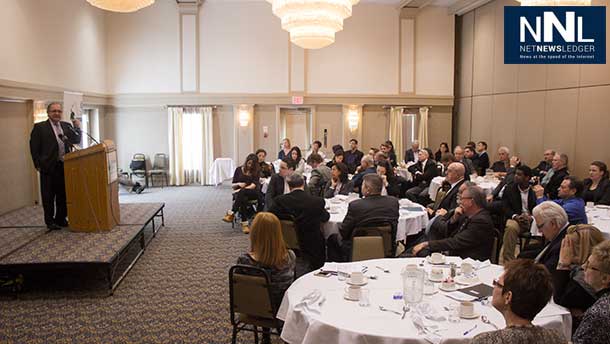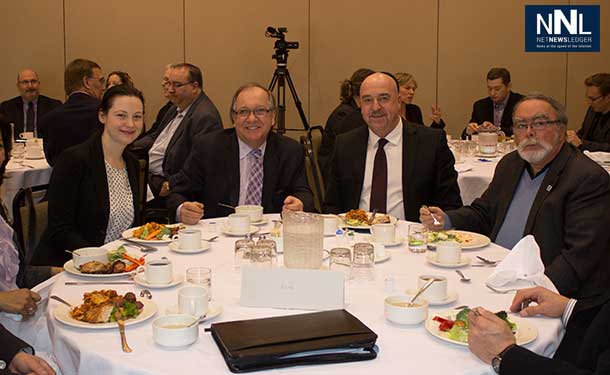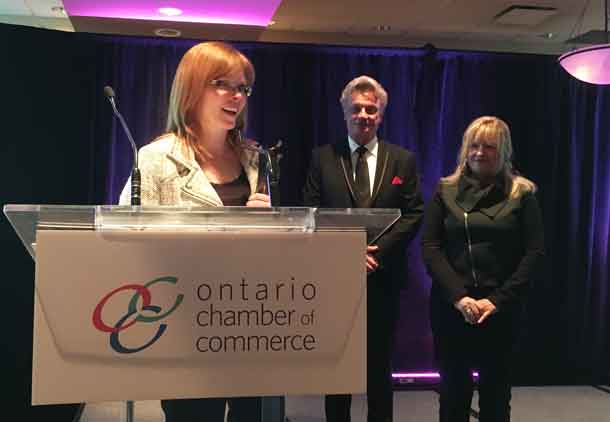Aboriginal Affairs Minister Shares Education Act
THUNDER BAY – Federal Minister of Aboriginal Affairs Bernard Valcourt addressed the Thunder Bay Chamber of Commerce at a luncheon today in Thunder Bay.
Here is what the Minister said:
Good afternoon ladies and gentlemen. Thank you for the warm introduction. It gives me great pleasure to speak with you today.
Bonjour Mesdames et Messieurs et je vous remercie d’être ici avec avec nous aujourd’hui pour discuter du Plan d’Action Économique 2014.
As a Minister in Prime Minister Harper’s Government, it is my privilege to meet with you to discuss our Government’s Economic Action Plan 2014.
I am proud to confirm that our Government is on track to return to balanced budgets in 2015, with new measures that will create jobs and opportunities.
We are on track to balance the budget while keeping taxes low and protecting the programs and services Canadians count on.
Since the inception of Canada’s Economic Action Plan in 2009, Canada has achieved the best job creation record and one of the best economic performances in the G-7 over the recovery.
Economic Action Plan 2014 builds on this record of achievement with positive measures to grow the economy and help create jobs by;
· Introducing a new Canada Apprentice Loan to help registered apprentices in Red Seal trades with the cost of training;
· Investing in programs to help older workers and persons with disabilities access the labour market;
· Creating thousands of new paid internships for young Canadians entering the job market;
· Making a major investment of $500 million in automotive sector support, investments in Canada’s forestry and mining sectors and more; And of course, investing to reform First Nation education which, as Minister of Aboriginal Affairs and Northern Development, I am very proud and excited about.
Our Government has made great strides to improve the quality of life of Aboriginal people in Canada. And one very significant commitment we have made is to work with our partners to reform First Nations education – real, sustainable reform, so First Nations students can have the same opportunities for academic success and access to good jobs as other Canadian students.

As members of a thriving business community, but also as parents or grandparents, aunts or uncles, whether you have school age children or not, I am sure you agree that education is an issue that concerns every single one of us. Every child has a right to a quality education, no matter where they live in Canada. A good education brings with it a host of benefits – it opens doors, creates opportunities and spurs prosperity.
An investment in First Nations students is not only an investment in their futures, but also an investment in the Canadian economy.
First Nation youth represent the fastest growing segment of our population, yet many are often held back by an average high school graduation rate of only 40 per cent – a totally unacceptable number. Too many students do not have the benefit of an education system that ensures they can graduate and become more active participants in our economic prosperity.
With more than 400,000 Aboriginal youth projected to be ready to enter the labour market over the next 15 years, helping Aboriginal youth to succeed in school and graduate is critical to increasing their participation in Canada’s economy. Their talents and their ambition should be part of the solution to Canada’s looming labour shortage.

As part of the business community here, this is a reality you know well. The Ring of Fire is a perfect example. It has incredible potential to benefit the Northern Ontario economy, including remote First Nations with a limited economic base. This project and others rely on partnerships with First Nations, including plans for skills training and hiring community members. The mining industry, in fact, is the largest private sector employer of Aboriginal people across Canada, and it needs more skilled workers today, and in the decades ahead.
If we look at this on a national level, over $315 billion in major resource developments have been identified to be in or near Aboriginal communities. And of course, the Canadian economy would benefit from an influx of young skilled Aboriginal employees across all business sectors and regions.
Last week I stood with the Prime Minister and the National Chief of the Assembly of First Nations to make a historic announcement about comprehensive reform of First Nations elementary and secondary education. This is a shared priority: we agree on the urgency of the intolerably low graduation rates in many First Nations schools. The opportunity we have before us with this historic reform can become our promise, not only to the next generation of students, but to this one.
After extensive consultations, we have agreed to move forward together with new legislation: The First Nations Control of First Nations Education Act. The Act will provide the legislative base required to ensure that children and youth on reserve have access to an education system with the structures and supports that are available to non-First Nation students across Canada they need and deserve. One that ensures students can transfer more easily between education systems and schools, meets or exceeds provincial standards, incorporates Aboriginal language and culture and, perhaps most notably, ensures First Nations communities themselves have the primary responsibility for day to day management of their schools.
The legislation will enable First Nations to make choices of how best to educate their children, and will create a system that is accountable to First Nations communities and parents for the education their children receive.
There are a few points I want to highlight that are significant about this joint announcement:
First, our Government made a commitment in Canada’s Economic Action Plan 2014 to invest over $1.9 billion in new resources to strengthen the on-reserve education system, providing First Nations children with access to a modern and accountable education regime that aligns with provincial education systems off reserve. This includes new funding to build and renovate schools, with $500 million over seven years for a new Education Infrastructure Fund, beginning in 2015-2016.
I believe this is the right investment for Canada – we must ensure that the people who will operate First Nation schools and education authorities can count on adequate, stable, predictable and sustainable funding—and that they have the 21st century tools to deliver excellent classroom education.
This new funding is critically important, but I have always said that funding alone is not the solution to improving opportunities and outcomes for First Nations kids.
Which brings me to my next point: This legislation will finally enable First Nations control over First Nations education.
For more than a year now we have been consulting intensively with First Nations, provinces, stakeholders and interested parties across the country to talk about the proposal for legislation and to listen to their views and their advice.
And what we heard during these consultations is that First Nations want control over their children’s education. They want a system that is respectful of their linguistic and cultural identity in which elders, parents, the communities play their necessary roles.
Further to this, this Act will ensure that provisions of the Indian Act that allowed for the establishment of Indian residential schools and the removal of children from their homes and communities are repealed.
On June 11th 2008, the Prime Minister of Canada made an impassioned and heartfelt apology to the First Nations people of Canada for the treatment of children in residential schools- a sad and shameful chapter in our nation’s history. In June 2012, Member of Parliament for Desnethé-Missinippi-Churchill River, Rob Clarke, introduced a Private Member’s Bill, Bill C-428, an Act to amend the Indian Act and to provide for its replacement, which would make a series of amendments to outdated and paternalistic sections of the Indian Act, which includes repealing all provisions relating to residential schools.
One way or the other, either through Bill C-428 or the First Nations Control of First Nations Education Act, antiquated language and references to Residential Schools will be removed; we can take another step on the path toward healing.
Another thing we heard during consultations is that First Nations want transparency and clear oversight and accountability so that communities and parents can drive better outcomes and results.
Last week’s announcement came after, and builds on, countless reports, from the Senate, the Auditor General, and the work of the National Panel on First Nations Education. After years of talk we know what is needed—action—and the time to act is now.
This legislation will create a path for the establishment of First Nations education authorities – similar to school boards – which will help ensure that schools can meet the requirements expected of them by their parents, their elders, their communities and this country. One of the key features of the legislation is that it will provide for the creation of a Joint Council of Education Professionals to guide and support the Government of Canada and First Nations on its implementation. The Joint Council will also lead the five-year review of the legislation.
We all want comparability in outcomes for First Nations children. We need a seamless transition for students between First Nation and provincial systems because we know that is not the case now and it is the students who pay the price.
The overriding goal of this legislation is better outcomes for First Nations students. It does not impact communities whose ultimate goal is getting to self-government in the education sector. This legislation will help those First Nations that choose to pursue education self-government agreements in the future.
It also complements and builds on the proven success of tri-partite education agreements, like the one I had the honour to sign with Nishnawbe Aski Nation last year. This education reform will also ensure that First Nations treaty and inherent rights will be respected and not hindered in any way.
In tandem with reforming First Nations education, we are also improving the on-reserve Income Assistance Program to help ensure First Nation youth can access the skills and training they need to secure a good job. I recently announced that 70 First Nations in six provinces and Yukon are set to deliver enhanced supports and access personalized skills and training for First Nation youth. At the same time, the Government is increasing the availability of training linked to employment for these young on-reserve income assistance clients through the new First Nations Job Fund.
So we are taking an ambitious and integrated approach to investing in better futures for First Nations youth. Looked at through an economic lens, I predict that this agreement on First Nations control over First Nations education will be the most important step ever taken to promote greater First Nation participation in their community, provincial and national economies.
Businesses are eager to work with First Nations communities across the country to create the jobs and economic opportunities that can benefit us all. They are ready to hire and train First Nations for steady, well-paying jobs. But the key to such jobs is a good basic education.
By working together with First Nations on education, we are helping First Nation communities throughout the country become healthier and more self-sufficient. We are helping the fast growing demographic group in Canada fully participate in this great country. That is good for First Nations, and it is good for Canada.






